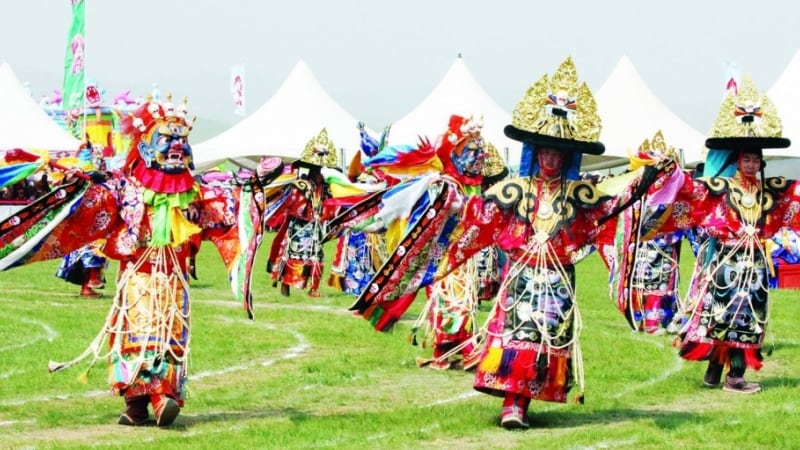The Tsam dance (mask dance) is an assembly of religious dancing by wrathful deities. The characters of tsam dancing are the fanciful figures of Buddhist disciples in their dreamy meditations. The dancing characters seek to drive out evils by their outer appearances and jumping. The dancing is not performed on any fixed day but rather on the occasions of certain events. The tsam dancing can be performed in any season or any day. This dancing is usually performed in the court of a Buddhist monastery. The blue, red, or yellow silken canopy is erected just opposite the main temple. In some cases four flags are placed besides it. Under the canopy, the skin of a tiger is laid out on the floor and a table covered with silk is placed on it. This is a place in which the dancing is conducted or the centre where the dancing will be constituted.
The first circle starts from the distance of one metre from the four pillars round the canopy. The circles are marked with lines of chalk. Two white circles are drawn at a distance of 6 or 7 metres from the first circle. The dancing is performed along places between these circles. Two parallel circles are drawn out of these drawn circles. These circles are dedicated to the dancers of Yamantag, the Wrathful. Two white lines are drawn from those lines to the main entrance of the temple. The wrathful deities walk along these lines. Those lines cross over each other. There are small circles on each cross, which are for the deities to stand prior to dancing. The clothing of the religious dancers is sewn without prints on their surface. The fabric is folded and the edges of the folded fabric are sewn together. The folded part of the fabric is notched into semi-rounded holes through which a head can go. The lower part of the folded fabric is flared up .The sleeves are widened and include an arrow case shaped in a way that allows the deities to conceal the arrows and bow inside their sleeves.
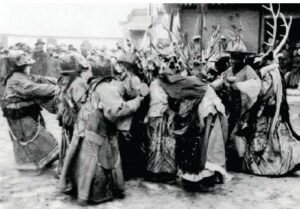
They put on cloaks with five pieces of ornaments over the above-mentioned clothing. They wear apron-shaped clothing with red or green coloured insertions round the waist. This insertion is hemmed with black silk and yellow and red ribbons are fixed onto it.
The deities wear eight big rosaries with bright yellow beads around their necks. The rosaries over the back and front of the deities can reach down to their waist. They tuck the prayer wheels with eight spokes into their sashes. Three yellow-ribbons are fixed with the prayer wheels and bells are attached to the middle ribbon. The edges of the ribbons are yellow. The masks of the dancing deities are modeled with the features of the wrathful faces.
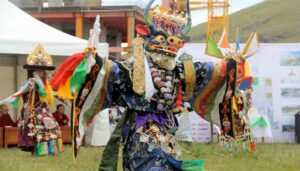
The sizes of the masks are sometimes twice as large as the size of an ordinary man’s face. Thus, these masks look huge. Those who put on the masks look huge-headed. The peculiarity of the masks of the deities is the decoration of five skulls. They have the appearance of a crown. Long red threads on the back of the masks imitate the red hair of the deities. Dancing monks do not wear masks. But they put on peculiar hats instead of masks. These hats are broad rimmed with oval cylindrical crowns. The hewn wooden skeletons are fixed atop these hats and hang down to the waists of the deities above them. There are also two curved horns connected with the sign of the wish-fulfilling gem.
The religious dancing starts by paying reverence to the Yamantag, the wrathful deity. After it, the effigy to be exorcised can be hallowed, which is followed by monks enteringthe congregation hall. The first monks to go out hold incense burners. The monks holding up sacred cakes come out next, followed by monks holding golden pitchers bearing tassels and evil effigies. Afterwards, the monks who will perform musical instruments come out. Then an evil effigy is placed on the specially arranged table. As soon as ganglin (a fife traditionally made of a human femoral bone) is blown, the religious dancing starts. Two dancers in skull masks and light white gowns patterned after a human skeleton start dancing. After them a team of crows comes out. They are clad in crow shaped masks with sharp bills and wear brown jackets and black flared trousers. The dancers in skull masks dance on two sides of the evil effigy. They try to snatch the evil effigy from the crow masked dancers. But the crow masked dancers hold up a wooden stick and keep them away from the evil effigy. By thus the first act of religious dancing ends. The second act starts with fast rhythmical music. As soon as the music stops the monks holding up a bloody skull in one hand and four sacred cakes and Mandala (representation of cosmos) in the other come out. They come to the evil effigy and shout “Argam” and pour the blood of the skull into the Mandala.
Afterwards, they stand up and come to the monks keeping the evil effigy and sit near them in the canopy. In response, the skull masked dancers run to the west or to the east and demonstrate various movements. They wave sticks at each other and run round the canopy six times and stand up on both sides of the canopy as sentries. The crow masked dancers attack the evil effigy from time to time. The skull masked dancers point out at them with sticks. When the ganglin is blown again, two Indian sages come out. Indian sages are from ancient India. Their masks look like the faces of ordinary human beings. The colours of their face are brown and the sizes are bigger than ordinary men. The mouths and noses are also made to look sarcastic. The Indian sages are clad in long brown silk gowns with silk blue sashes. Their hair is combed and worn in pigtails or in buns. They do not enter the circles of dancing, instead staying at the main temple, moving their arms and legs in various ways. Their main duty is to welcome King Chakravarti.
At the next sounding of gangling, King Chakravarti and his queen and prince come all together. They are in ordinary Indian gowns. The king holds up a pitcher in his hand and is accompanied by two Indian sages with their unsheathed shields slung over their shoulders. At the beginning of the circulation, the Indian sages welcome them and prostrate and strew flowers over their path. They invite the king and his attendants to be seated upon a specially arranged divan. As soon as the king and his attendants sit down, those Indian sages stand as sentries on both sides. Then the gangling is blown again. King Khashan, accompanied by six small princes comes out. They are in Mongolian gowns. King Khashan puts on his robe.
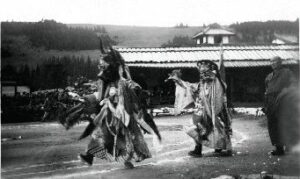
The princes hold up musical instruments. There is a myth that King Khashan welcomed the saints which turned into other forms and came down from heaven to the planet. Therefore, King Khashan welcomes attending Buddhists with sacred scarves.
The cymbals then strike three times and the gangling is blown. The Choijoo Buddha’s attendants come out. Those attendants are called Bojuud. King Khashan bows and welcomes them. The attendants come to the first circle of dancing. The Indian sages welcome them and pour flour before them. The attendants jump over all the circles during their dancing. The dancing is mostly jumping by alternating their legs and hopping on two legs, squatting, and running in a circle. These are their total dancing movements, and then the attendants come back to their main temple. The faces of the next two attendants are brown. The face of the third attendant is blue. The face of fourth one is green.
The cymbals strike nine times and the ganglin is blown. Two masked men from sham country appear. One of them, called Mankhi, wears a cow-headed mask. The other, called Deer, wears a deer-headed mask. They both hold a shield in their right hand and a skull in their left hand. The Indian sages pour blood at the moment they appear.
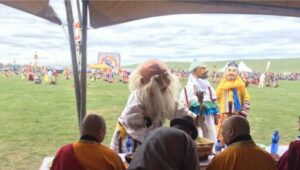
Afterwards, the mask of Vajrapani (Ochirvaan‘) appears. He holds a thunder bolt in his right hand and a lasso made of twisted silk in his left hand. The myth says that Vajrapani catches evil with the lasso. The Indian sages pours blood before the mask of Vajrapani. Then the mask of Lkham Buddha appears. He holds up a cleaver with a thunder bolt handle in his right hand and a skull in his left hand. The Indian sages pour blood before him. The black faced mask of Gombo Buddha appears. He holds up a cleaver with a thunders bolt handle in his right hand and a skull in his left hand. The Indian sages strew flowers before him.
The gangling sounds nine times. There are two reincarnations of Lhkam Buddha. The lion headed one is Sengedongin. The other, crocodile-headed one is Chusrendonjan. They appear holding shields in their right hands and snakes in their left hands. The Indian sages welcome them by strewing grass. Then Sendem appears holding up a forked stick and a skull in his hands. Afterwards, Namsrai (lord of wealth) appears holding up a victorious banner in his right hand and nets in his left hand. The Gombo guru appears holding a pitcher in his right hand and a Chandamani (wish-fulfilling gem) in his left hand. The Indian sages welcome them by strewing flowers. The attendants of the Jamsran Buddha appear in pairs. They hold shields in their right hand and skulls in their left hand. The Indian sages receive them by pouring blood. Their masks are wrathful figures with a flaming skull. He holds a red-hot shield in one hand and a blood-dropping heart in the other hand.
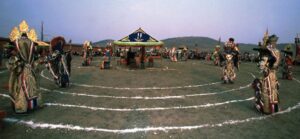
The masked White Old Man is a hunched bald man with a big white bearded, wearing a white gown, and wearing a large pouch. With a knife and cup bag in his sash, he leans heavily on his dragon-headed walking stick. The White Old Man is carried on a carpet from the main temple and placed on the middle of the circles of dancing near the evil effigy. He reclines for a while and then gets up and strokes his beard. He looks around with his hand shading his eyes and then stands up and dodders along. At this moment the skull-masked man gives a glass of milk-vodka to the White Old Man. He drinks it and then staggers for a bit, but then recovers and speeds up his movements. He dances until he becomes exhausted and falls. After the fall, he gets up and starts working on a sheep skin which is given to him by the Indian sage.
Following the White Old Man, thirty-two representative monk dancers appear in pairs. King Khashan receives them. The Indian sages strew flowers at their feet. They hold up knives and skulls in their hands and dance and jump within the first circle of dancing for long time. At the end of this act, a blue bull-headed Choijoo Buddha with unusually big flaming horns appears. The mask has five skulls and a thunder bolt on its top.
King Khashan welcomes Choijoo, but those Indian sages pour blood full of skulls. After jumping he stays together with other wrathful deities in the middle of dancing circle. At this moment the monks chant the Lotus Sutra. A monk brings the sutra out of the main temple. Afterwards, Jamsran with a shield in his hand together with his attendants comes out while monks chant from the sutra. Choijoo, Jamsran and others jump round the circle. Then the evil effigy is burnt. Choijoo and others in succession come back into the main temple. At last, the representative dancers come back into the main temple, thus ending the ceremony.
Ceremonial Performance of the Maitreya Buddha
The ceremonial performance of the Maitreya Buddha of Vajra-yana was formed and practiced in temples of the yellow sect of Mongolia. Together with its rites and chanting, it spread widely and became very a significant ceremony, especially while the sovereign state of the Bogd Khan existed. The Bogd Khan and other Buddhist saints declared the day to perform a ceremony of Maitreya Buddha with all the proper solemnities at the Gandan Monastery and at its branches of Ikh Khüree. There were very religious rituals which could be called as a grand demonstration around the temple. There is a view that Buddha in the form of the Maitreya Buddha may revisit this planet and resurrect his teachings in the next epoch. The Maitreya Buddha revisits and practices benevolence for the goodness of all beings in six realms. The purpose of the ritual is clear.
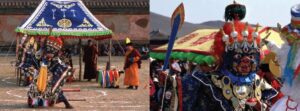
All the temples and monasteries prepare for ceremonial performances of the Maitreya Buddha. The congregation for the ceremonial performance of the Maitreya Buddha starts at five o’clock every morning for almost ten days before the ceremonial performance. This congregation starts at sunrise on the appointed day of the performance and ends at six o’clock. The Maitreya Buddha is enshrined in a small glass case and transferred on a two-wheeled cart with a green wooden horse made of papier-mache.
The head of the monastery (khamba lam) and his subordinate monks take the gilded statuette of the Maitreya Buddha out of the temple; dignitary monks, organized according to rank, carry sutras containing five classes of works about the Maitreya Buddha and set them before the statuette of the Maitreya figure. Monks burn juniper needles and incense and offer flowers, seven treasures of the state, auspicious eight offerings and offerings of five desires. Thus, the ceremonial performance of the Maitreya Buddha starts. The high dignitary monks clad in tall hats are at the head of procession. They are accompanied by the monks of monastery, trumpeters, and conch-blowers.
During the ceremonial period almost twenty monks take the lashes of horse and attach them to the cart and drag the cart before the procession. Two monks holding the tails of tigers and five monks holding whips have the duty of controlling the crowd of devotees. The procession starts from the door of the congregation hall and go out of the door of the court. The cart with the Maitreya Buddha is turned clockwise and stops to look to the congregation hall.
This ceremony starts with offering a Mandala to the Maitreya Buddha and requesting the Maitreya who supports the exalted one’s cause to give his sacred teachings. It also instructs these participants to abide by these teachings. Then the cart with the Maitreya Buddha is turned clockwise. They drag the cart with the Buddha and walk slowly around the monastery accompanied with soft musical tunes. This kind of moving should be like an elephant plodding along as the sutra says. They stop at the north of the monastery and make an offering and chant. Then monks make a break and leave the cart there.
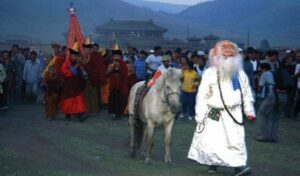
After almost three hours monks gather and sit before the Maitreya Buddha and congregate to attain the sanctity of Buddha-hood including reception and benevolence chanting and get reincarnation in the land of happiness. The cart is moved to the door of the eastern side of the monastery and the Idol is placed facing the south. Then the monks congregate and chant five kinds of works about the Maitreya Buddha. The two or three pieces of sutra are distributed to each chanting monks.
The procession of the Maitreya enters the main door of the monastery while the monks congregate and chant. The Idol is placed in the main temple, thus bringing this ceremony to a close.

